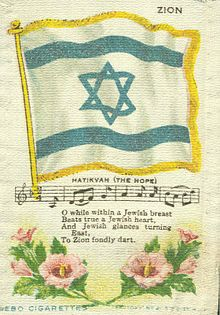Hatikvah - the official anthem of Israel
When we look around in our community, we find many who have the hope in their hearts to be united together in the God-promised Land.
In 1886, the Galician poet Naphtali Herz Imber wrote nine romantic verses that evoke familiar Biblical scenes and repeats the hope our people have in the writings about a national return to Israel that only disappears with the last Jew entering it. The text of Imber was later slightly modified by Doctor I.L. Metman Hacohen, a teacher from Tel Aviv, in 1905.
Imbers nine-stanza poem verses, Tikvatenu ("Our Hope"), and the adaptations of Metman Hacohen were used side by side for a long time.
In 1888 Samuel Cohen composed to a musical theme derived from a Romanian folk song [presumably "Carul cu boi" (English: "Transport with oxen")] which in turn borrowed her melody from "La Mantovana", an Italian composition by the 16th century by Giuseppino del Biado. During the renaissance, this melody was widespread in Europe.
In the Zionist movement the song became popular very quickly and was chosen as the organizational anthem of the First Zionist Congress in 1897 and the first two stanzas came to act as an ad hoc anthem at the sixth Zionist congress in 1903 in Basel, Switzerland. However, it took until 1933 before Hatikvah was ratified as the official song of the Zionist movement.
When independence was proclaimed in 1948, the choice of the Israeli national anthem went out to this musical work, which, however, had to wait until 2004 to officially obtain the status as such for the first time in main legislation.

The official text of the national anthem corresponds to the first stanza and amended refrain of the original nine-stanza poem by Naftali Herz Imber. Along with the original Hebrew, the corresponding transliteration
Hebrew lyrics
| Modern Hebrew | Transliteration | Phonemic transcription (IPA) |
|---|---|---|
First verse | ||
כֹּל עוֹד בַּלֵּבָב פְּנִימָה | Kol ‘od balevav penimah | /kol od balevav penima/ |
Second verse | ||
עוֹד לֹא אָבְדָה תִּקְוָתֵנוּ, | ‘Od lo avdah tikvatenu, | /od lo avda tikvatenu |/ |
| Literal | Poetic |
|---|---|
As long as in the heart, within, | O while within a Jewish heart, |



